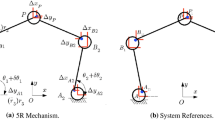Abstract
This paper investigates the rotatability of planar parallel mechanisms by revealing the crank conditions that relate to link parameters. The paper extends the theorem of assemblability and the rotatability criterion and applies these criteria to parallel mechanisms in investigating the crank conditions of a parallel mechanism, leading to classification of three types of crank existing conditions including three-crank’s, six-crank’s and nine-crank’s of 3-RRR planar parallel mechanisms. The results are summarized as constraint conditions in relation with link parameters with a concluding table and case studies.
Similar content being viewed by others
References
Gough V E. Contribution to discussion of papers on research in automobile stability control and tyre performance. Proc Auto Div Inst Mech Eng, 1956. 392–395
Stewart D. A platform with six degrees of freedom. Proc Inst Mech Eng, 1965, 180(5): 371–378
Hunt K H. Structural kinematics of in-parallel-actuated robot arms. ASME J Mech, 1983, 105(4): 705–712
Ting K L. Mobility criteria of single-loop N-bar linkages. ASME J Mech, 1989, 111(4): 504–507
Ting K L, Liu Y W. Rotatability laws for n-bar kinematic chains and their proof. ASME J Mech Des, 1991, 113(1): 32–39
Shyu J H, Ting K L. Invariant link rotatability of n-bar kinematic Chains. ASME J Mech Des, 1994, 116(3): 343–347
Dai J S, Shah P. Orientation capability of planar serial manipulators using rotatability analysis based on workspace decomposition. Proc Instn Mech Engrs, 2002, 216(C4): 275–288
Dai J S, Shah P. Orientation capability of planar manipulators using virtual joint angle analysis. Mech Mach Theory, 2003, 38(2): 241–252
Li R Q, Dai J S. Orientation angle workspaces of planar serial three-link manipulators. Sci China Ser E-Tech Sci, 2009, 52(4): 975–985
Gosselin C M, Sefrioui J, Richard M J. Solutions polynomials au problème de la cinèematique directe des manipulateurs parallèles plans à trios degrès de liberté. Mech Mach Theory, 1992, 27(2): 107–119
Gao F, Liu X J, Chen X. The relationships between the shapes of the workspaces and the link lengths of 3-DOF symmetrical planar parallel manipulators. Mech Mach Theory, 2001, 36(2): 205–220
Guo W Z, Du R, Wang J X. On the mobility of single loop n-bar linkage with one prismatic joint. In: ASME 2005 Design Engineering Technical Conferences and Computers and Information in Engineering Conference. California: ASME, 2005
Liu X J, Wang J, Gao F. Performance atlases of the workspace for planar 3-DOF parallel manipulators. Robotica, 2000, 18(5): 563–568
Author information
Authors and Affiliations
Corresponding author
Additional information
Supported by the Natural Science Foundation of Shanxi Province in China (Grant No. 20041070)
Rights and permissions
About this article
Cite this article
Li, R., Dai, J.S. Crank conditions and rotatability of 3-RRR planar parallel mechanisms. Sci. China Ser. E-Technol. Sci. 52, 3601–3612 (2009). https://doi.org/10.1007/s11431-009-0290-2
Received:
Accepted:
Published:
Issue Date:
DOI: https://doi.org/10.1007/s11431-009-0290-2




